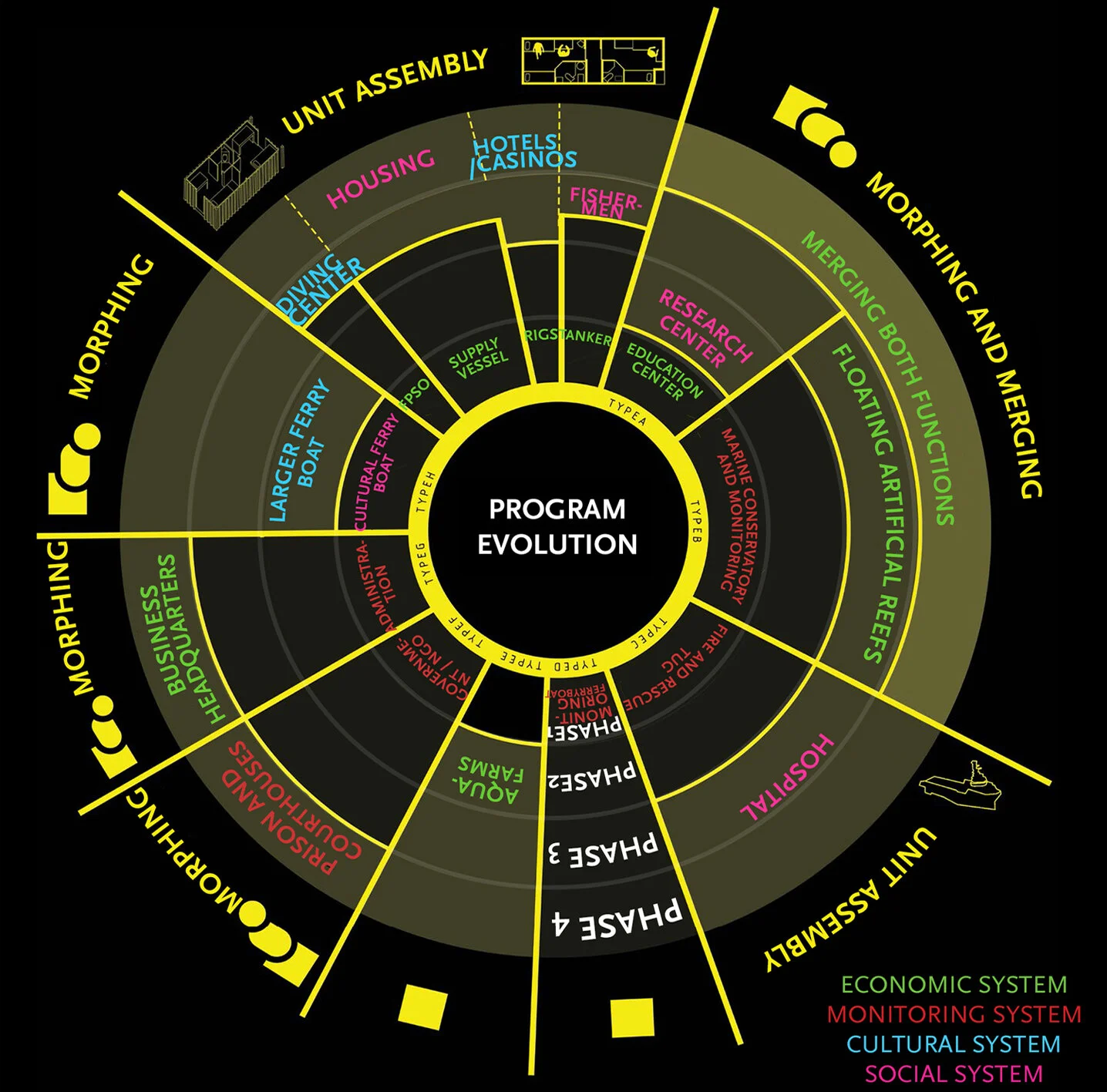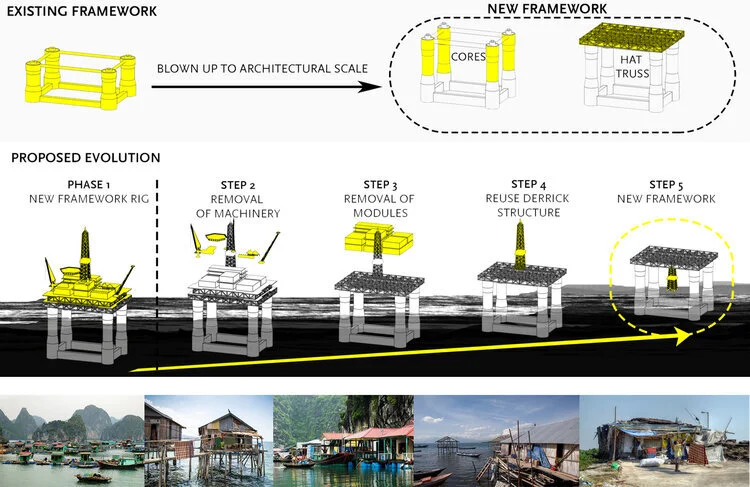This project is hosted on my older website.
For my latest (still-in-progress) work, visit www.karenasmar.com.
Undergraduate Thesis | Global Winner Award in UA 2018 Oil & Gas Industry —
Beyond Rigging
Disrupting the Oil & Gas Industry
CHALLENGE
More often than not, it is only when infrastructural systems fail and become obsolete that their material presence comes into awareness. Instead of solving the problem at the end by reinhabiting or finding new purposes for a structure, how can architects intervene from the very start to design for contingency, longevity and resiliency of infrastructural systems?
SOLUTION
The project takes the oil and gas industry in Lebanon as a case study and tackles it on two scales: the macroscale, by reimagining the evolution of the different components that compose the network of the industry and the microscale, by creating an integrated solution and new disciplinary rig hybrids that respond to new and unpredicted challenges that might arise.
Design interventions on both scales aim to rethink the industry from the start for more than the mono-function it is intended for and for greater social, spatial, economic and ecological benefits.
CONTEXT
Thesis Project
American University of Beirut
2017
AWARD & PUBLICATION
Global Winner in Architecture
in the Undergraduate Awards (UA)
2018
TAGS
Systemizing Architecture,
Resilient Design,
Infrastructure as Architecture
Identifying Problem —
Research01 *
Problem of Obsolete Infrastructure
Infrastructure falls within the realm of the engineers. Engineers rely on standardization of these systems and prioritize technical efficiency and productivity over social, ecological and aesthetic aspects.
However, nowadays, this first batch of engineered infrastructure, built a century ago, has aged, become obsolete, failed to respond to environmental and economic shifts and no longer serves the sole purpose for which it was initially built for.
New Mindset
Yet, only when these systems collapsed did their material presence come into awareness. Also, that is when architects are called to intervene and find new purposes for the redundant facilities left behind.
Hence, a new mindset to design the future batch of infrastructure is crucial.
Case of the Oil & Gas Industry in Lebanon
Limitations of the Industry
The oil and gas industry has a limited lifespan of +or– 30 years. If Lebanon adopts the traditional existing systems utilized worldwide, the project will be limited by its singular performance objective.
Yet, by transforming moments within the web of infrastructural system, architecture and infrastructure can be combined into a successful, resilient performative system that extends the industry beyond the decommissioning phase.
Ecological Impact
Rigs invade and amputate the marine life and change its ecological division, they alter the migration of the birds and even affect other industries such as fishing industry.
Hence, extending the lifespan of these rigs by integrating them ecologically in their surroundings becomes the most ecologically viable and resilient approach.
Defining Approach —
Methodology02 *




Systemizing Architecture
Hybridizing “infrastructural systems” with “architectural objects” materializes infrastructure’s disposition to expand into other usages when the engineering services become obsolete.
But first, understanding the notion of a “system” in architecture is crucial.
Three Categories
When systemizing architecture, three categories can be deduced:
- As Part of a Larger System: Architecture’s scale is blown up to encompass the whole city and create mega-structures.
- As a System of Subsystems: Architecture is deconstructed into different layers of its main constituents.
- As a System of Lifespans: A lifespan is assigned to each layer within the architectural object.
Design Approach 1 —
Macroscale: Network03 *
Network as Site
In the current system, the network consists of hard infrastructure of which the rig is the center. Eventually, rigs stop functioning, the network deteriorates and components of the network become limited to a life shorter than their expected lifespan due to the interdependency of the system.




Phasing
Decentralizing the Network
Installing soft infrastructure into the network ensures the durability and longevity of the system. This integration with the public produces new hybrids from the start between the industry and the social sector to increase the lifespan of the network’s components, and it proposes a constant programmatic exchange between the production process and the social process to allow a smooth transition to the new network at sea.
Hence, by this, the oil and gas industry becomes a part of a larger social network that unfolds over a certain period of time.
Program Evolution
All components have both: a life within the system and a life of their own. Together, these programs work as architecture. With time, typologies either morph and evolve into other functions or combine together and assemble into a larger whole.
Some programs are hijacked and hybridized from the start to form new “social” typologies:
- Buoys become a marine conservatory and monitoring center
- Crew vessels become a cultural crew ship
- Fire and rescue tugs become micro floating hospitals
Also, oil rigs function as independent structural bases which can be repurposed as reefs, diving centers, housing, etc.
Scenarios of Transformation
Soft infrastructure is categorized into 4 main systems: Economic, Monitoring, Social and Cultural Systems.
Program Distribution and System Evolution
Different “agents” dominate in each phase so that when the rigs cease to function, the systems re-adapt to other uses and form new connections.
Design Approach 2 —
Microscale: The Rig04 *
Rigs as Site
Removing the rigs from the sea is an extremely expensive process. Hence, knowing that the structural lifespan of a rig drastically exceeds its economic lifespan, governments and organizations rely on architects as an afterthought to re-purpose these huge structures after they become obsolete.
Achieving Resiliency of Rigs
Yet, this system, engineered a century ago, cannot remain utilized in the same way today. Infrastructure should be designed in a flexible way to allow it to avoid the abandoned phase and adapt directly to change when a need arises.
Hence, rather than recycling afterwards, deconstructing the rig into its components and their lifespans helps identify the best area to intervene from the start in order to achieve resiliency. This opens up opportunities for new spatial results with higher returns socially, spatially, ecologically and economically.
“Our basic argument is that there isn’t any such thing as a building. A building properly conceived is several layers of longevity of built components.”
Rig Evolution
Rather than the traditional typology of the rig, a new designed multi-performative infrastructure responds to social, ecological and aesthetic conditions and produces a resilient infrastructure that avoids redundancy. Infrastructure, then, becomes the framework upon which the architectural transformation takes place. When decommissioned, buoyant force will push the rig upwards and allow it to begin its “second life” as a fisherman community center.
Coupling the infrastructural rig with architecture guarantees maximum potential over its lifespan.
Volumetric Development
Structural Analysis
Buoy Energy
The rig produces its own energy by relying on wave buoys that cover its facade. These buoys also act as wave breakers for the harbor and fish farms they enclose.
Program Distribution




Plans





Sections


Physical Models



















